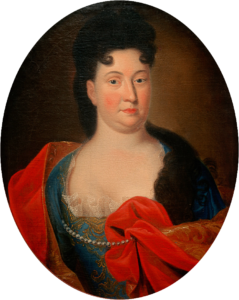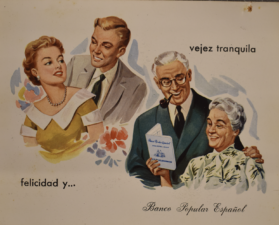In 1720, leading politician Robert Walpole confided in his colleague Earl Cowper that he “did everything” by the Duchess of Kendal and that she was “in effect as much Queen of England as ever any was.”[i] The Duchess was Melusine von der Schulenburg, and by that time she had been the mistress—and possible second wife—of George I of Great Britain and Hanover for almost thirty years. Walpole’s comments reveal a great deal about the power that Melusine wielded at court, and they demonstrate how important she was to the conduct of political business. For all her supposed power, though, she was never crowned queen and has largely been forgotten by history.[ii] Thus, it is the purpose of this blogpost to ask: just who was the Duchess of Kendal?
Ehrengard Melusine von der Schulenburg, known always as Melusine, was born in 1667 in the Duchy of Magdeburg, 100 miles east of Hanover. In 1690, Melusine travelled to the Brunswick-Lüneburg court to become a maid of honour in the household of Duchess Sophia of the Palatinate. It was there that Melusine met George, then the Hereditary Prince of Brunswick-Lüneburg, who was unhappily married to his cousin, Sophia Dorothea of Celle. Both parties had begun to look elsewhere, and George found himself drawn to Melusine. The pair had much in common, particularly their shared love of music and the theatre. There was no advantage to Melusine becoming George’s mistress, however. She came from an aristocratic family with a pedigree that stretched back to the thirteenth century and a liaison with George would have damaged her marital prospects. Their romantic attachment was therefore unlikely to have been a social or political expediency. The length of their relationship suggests that it was mutual attraction and, perhaps indeed, love which brought them together.
The relationship must have begun in 1691 at the latest as their first daughter was born in 1692, with two further daughters born in 1693 and 1701. These children were never legitimised or publicly acknowledged by either parent. They were instead registered as the daughters of two of Melusine’s sisters, but they remained in Melusine’s care and were raised at the Hanoverian court. George’s position in this regard was made difficult by the dramatic events of 1694 which had culminated in his divorce, the murder of Sophia Dorothea’s lover, Count Philipp Christoph von Königsmarck, and her imprisonment for her part in the affair.[iii] The European-wide scandal this caused made George wary of ever doing anything to resurrect the subject. This may account for why George never officially married Melusine. The prohibition that English church law put on remarriage if the previous spouse was still alive undoubtedly also played its part.
The divorce, and George’s accession to the throne in 1698, transformed Melusine’s position. They began to live openly together and made their home at the palace of Göhrde. Melusine began to act as George’s hostess, presiding over parties and other social events at Göhrde as well as at Herrenhausen and the Leineschloss. She was acknowledged by the Hanoverian elite as the most important woman in the electorate, second only to the Dowager Duchess. Melusine also won the affection of George’s wider family, fostering a warm relationship with his legitimate children, Sophia Dorothea of Hanover and the future George II, and later with his daughter-in-law, Caroline of Brandenburg-Ansbach. Melusine also began to develop a political role. Ministers, and indeed members of George’s family, came to her first with matters they considered too delicate or difficult to raise directly with the Elector.[iv] This continued after George I became king of Great Britain in 1714, as reflected in Walpole’s comments, and it demonstrates that Melusine was not only George’s domestic partner but his social and political partner, too.
After 1714, George I’s preference for privacy saw the Prince and Princess of Wales lead on court functions and become the social focal point of the dynasty. As a result, Melusine’s social role reduced and she instead presided over private supper parties in her apartments which were held for the King and his close circle.[v] The rift between the King and the Prince of Wales in 1717 resulted in Melusine having to take on a more public role to support George I’s increased visibility at court. [vi] Melusine again retreated into the background after George and his heir were reconciled. Melusine was not entirely invisible to the British public, however—she and George would often attend the opera together with their daughters.[vii] Nor was she hidden from the Hanoverian public, as she always accompanied George back to the electorate when he visited.
Melusine could be highly visible, but her role was obscured and confused by the ill-fitting term ‘mistress’ that was used to describe her. She was also obscured by ‘The Maypole’, an epithet bestowed upon her by the British public that became synonymous with the caricature of Melusine as a “money-grabbing harpy.”[viii] Similarly, George’s half-sister, Sophia von Kielmansegg, was given the offensive moniker of ‘The Elephant’ and was wrongly assumed by the gossips of the period to have been another mistress. The full extent of Melusine’s role during the reign of George I has yet to be fully explored by historians. This has only been a brief look at her life, with much left unsaid.[ix] But it is clear Melusine was important to George I both as a romantic companion and as a social and political partner. Though she was never crowned queen, she was, in every way that mattered, the consort of George I. Melusine may be one of Britain’s forgotten consorts, but she is worth remembering.
Amy-Jane Humphries is a first year PhD student at the University of Liverpool. Her research explores the roles of the princesses of Wales and royal mistresses at the courts of George I and II with a particular focus on how they changed and developed in the absence of a queen consort.
Image from wikipedia
[i] Mary Clavering Cowper, Countess Cowper, Diary of Mary, Countess Cowper, Lady of the Bedchamber to the Princess of Wales, edited by The Hon. Spencer Cowper (London: J Murray, 1865), 132.
[ii] Ragnhild Hatton, George I (New Haven: Yale University Press, 2001), 63.
[iii] For more on this, see: Hatton, George I, 48-68.
[iv] Hatton, George I, 51.
[v] John M. Beattie, The English Court in the Reign of George I (Cambridge: Cambridge University Press, 1967), 261.
[vi] Beattie, The English Court, 264.
[vii] Hatton, George I, 133-34.
[viii] Hatton, George I, 154.
[ix] For a comprehensive biographical account of Melusine’s life, see: Claudia Gold, The King’s Mistress: The True and Scandalous Story of the Woman Who Stole the Heart of George I (London: Quercus, 2012).

